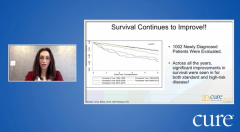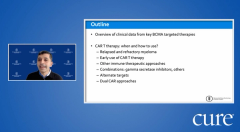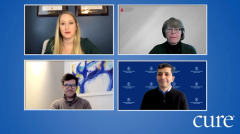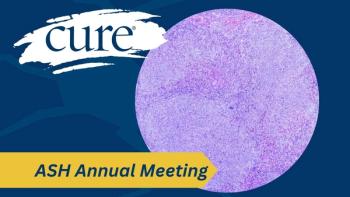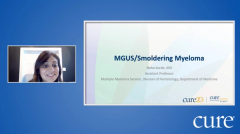
Educated Patient® Multiple Myeloma Summit Risk Stratification for the Newly Diagnosed Presentation: March 12, 2022
Watch Dr. Carlyn Rose Tan, an assistant attending in myeloma service at Memorial Sloan Kettering Cancer Center, present on risk stratification for newly diagnosed patients.
Risk stratification can be beneficial in guiding treatment options and paths for patients with multiple myeloma; however, gaps still remain in this area, according to one expert.
Dr. Carlyn Rose Tan, an assistant attending in myeloma service at Memorial Sloan Kettering Cancer Center in New York, discussed this further during her presentation at CURE®’s Educated Patient® Multiple Myeloma Summit.
Tan explained that risk stratification involves the assessment of different factors that may affect survival or duration of response from various
In particular, Tan said clinicians look for specific chromosome abnormalities such as deletion 17p; 4;14 translocation; and translocation 14;16, among others that can be found during an initial bone marrow biopsy and can help guide treatment decisions. Additionally, some high-risk features evaluated during risk stratification include the staging of the disease, if there are plasma cells circulating in the blood or if there is evidence of soft tissue plasma cells that are growing outside of the bone, she said. All of these factors are critical to guide a patient and provider throughout treatment and make more informed decisions for their specific disease.
“It’s important because it can sometimes guide how we move forward with therapy, whether or not transplants would be an important indication in the upfront setting, things like that,” she said in an interview with CURE®.
For example, she explained, recent data have demonstrated that patients with translocation 11;14 (a specific protein within the myeloma cells) may be more sensitive to Venclexta (venetoclax) than patients without this translocation. Risk stratification allows for more targeted treatment approaches for certain patient subgroups, Tan added.
When risk stratifying a patient with multiple myeloma, a physician can decide whether more aggressive treatment, such as a quadruplet regimen, would be beneficial or if a
“We want to be able to prolong that response as long as we can,” she added.
It is also beneficial because it may qualify a patient for a clinical trial, which may prolong survival for some patients. Tan explained that there are many clinical trials available for patients with multiple myeloma who are high risk.
“And so these patients can enroll in a study and perhaps we can change or improve survival for patients with high-risk (multiple) myeloma,” she said.
Although risk stratification can be beneficial in guiding treatment options for patients, there are still gaps, Tan said. Currently, there is no gene expression profiling, meaning a way to evaluate different types of genes a patient may have and if that is associated with a certain level of risk. More information is also needed regarding how to target mutations with certain lines of therapy.
“Multiple myeloma is known to still be a heterogenous disease, so even patients that have certain high-risk features, not all patients respond similarly to the same type of therapy. And I think we need to tease that out a little better,” she said.
Tan said risk stratification is still a work in progress and there is continues to be development in order to better understand what treatments can benefit which patients best.
“The field of (multiple) myeloma has evolved significantly. But we are still learning how to best risk stratify patients in order to serve them better with the treatments that we have available and develop more (and) better treatments for the future as well. And so this will continue to evolve as we continue to learn more about the disease process,” she concluded.
For more news on cancer updates, research and education, don’t forget to




